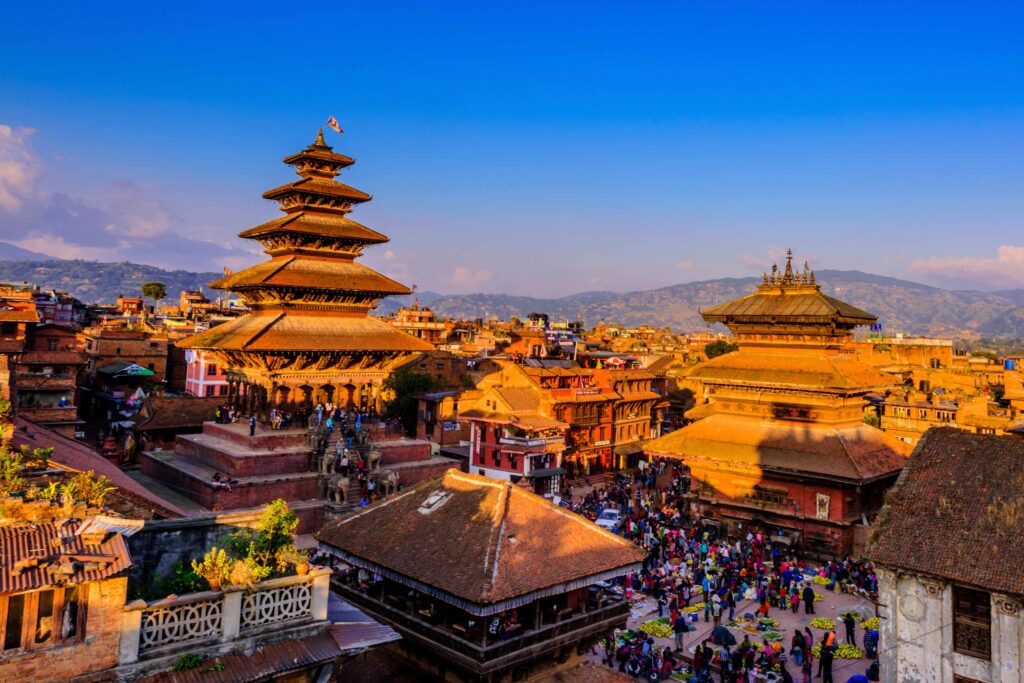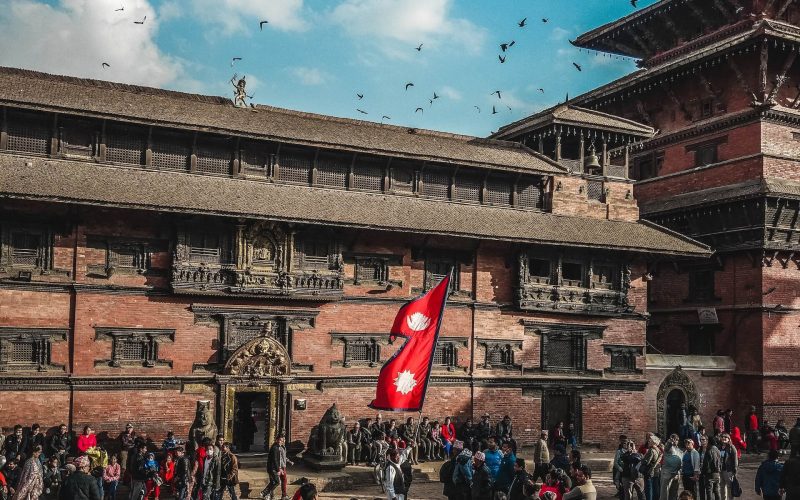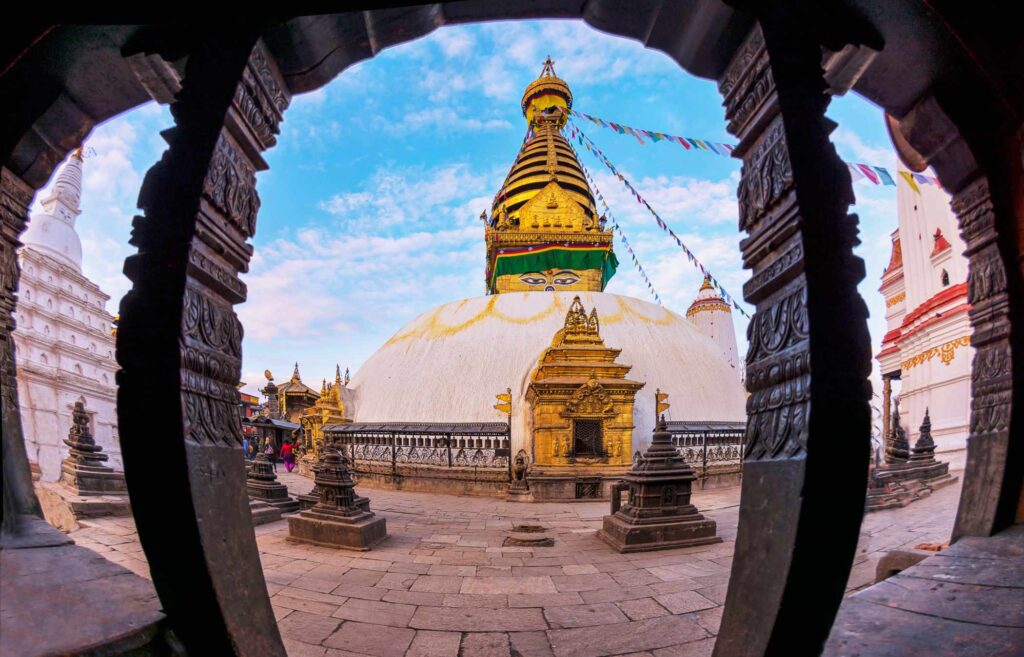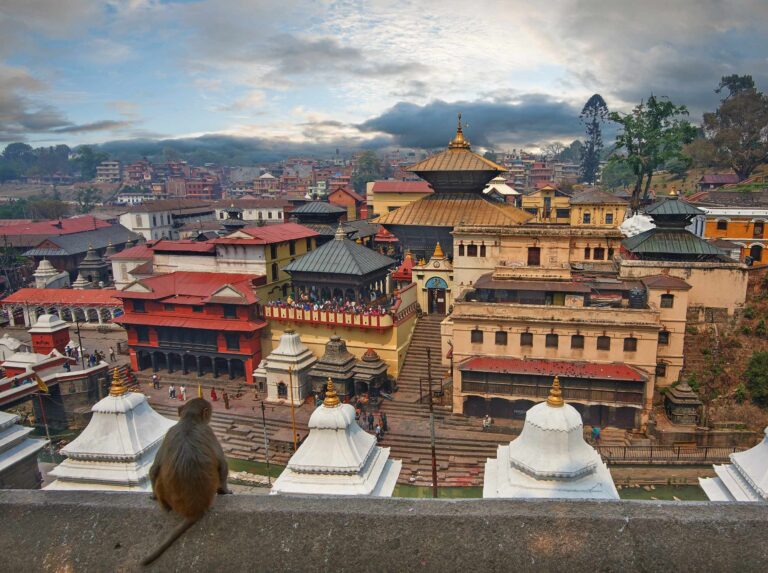Historical Places In Kathmandu Valley
Nepal, a historical gem untouched by British rule, boasts a distinct culture influenced by neighboring China and India. Embraced by the magnificent Himalayas, its natural splendor is complemented by a rich decoration of Hindu and Buddhist ideologies. Particularly in Kathmandu, the capital, Nepal’s heart pulses with vibrant history and spirituality, offering many cultural attractions for visitors.
Kathmandu Valley stands as Nepal’s epicenter of tradition and history. This bustling region encapsulates Nepal’s storied past, from majestic palaces and ancient temples to serene monasteries and stupas. Each monument, a testament to ancient eras, whispers tales of the nation’s renowned heritage, making the valley a must-visit for those fascinated by the intertwining of culture and history. This vibrant valley is a treasure trove of historical places of Kathmandu and a testament to the nation’s illustrious past.
As a hub for Hindu and Buddhist followers, this valley promises a unique blend of spiritual experiences, beckoning global enthusiasts to explore its world heritage sites. From grand palaces and ancient temples to monasteries and stupas, the valley holds stories of centuries gone by.
Let’s journey through the mesmerizing historical places in Kathmandu and discover what makes each unique.
Top 10 Historical Places in Kathmandu Valley
1. Bhaktapur Durbar Square

Bhaktapur Durbar Square is a living museum of medieval art located just 15 km east of Kathmandu. It is a UNESCO World Heritage site and a living testament to Nepal’s rich heritage. The heart of Bhaktapur city, it’s a mosaic of ancient Newari culture, showcasing medieval art and architecture.
The square comprises four distinct areas: Durbar Square, Taumadhi Square, Dattatreya Square, and Pottery Square. It boasts iconic landmarks like the 55 Window Palace, a symbol of the valley’s monarchial history, the towering Nyatapola Temple, and the exquisite Golden and Lion’s Gates. The craftsmanship in the wooden carvings and the architectural brilliance of its structures set it apart.
Known also as Khwopa or Bhadgaon, Bhaktapur was the birthplace of the renowned Newari craftspeople. Visitors to the square can explore pottery and statue shops that echo the city’s artisanal legacy. The Bhaktapur art gallery, the statue of King Bhupatindra, and the fifty-five-windowed Malla palace are must-see attractions.
While the city’s architecture offers a visual feast, its culinary delight, Juju Dhau, or the “king of yogurt,” is a treat one shouldn’t miss. Bhaktapur Durbar Square offers a rich tapestry of history and culture for those seeking a concise journey into Nepal’s medieval past.
Key Attractions of Bhaktapur:
- 55 Windows Palace
- Nyatapola Temple
- The Vatsala Temple
- Dattatreya Temple
- Golden Gate and Lion’s Gate
2. Patan Durbar Square

Another gem among the historic places in the valley, Patan Durbar Square, located only 5 kilometers from Kathmandu, is a UNESCO World Heritage site and a testament to the rich history of Lalitpur, also known as Patan. Founded by the Kirat dynasty in the 3rd century and later embellished by the Lichhavi and Malla kings, the square boasts ancient Nepali craftsmanship, a testament to centuries of art and architecture.
Lalitpur, the oldest of the three cities in the Kathmandu Valley, is distinguished by the Bagmati River and is home to the iconic Patan Durbar Square. Surrounded by four ancient stupas constructed by Emperor Ashoka in the 3rd century B.C., the area is a mosaic of temples, palaces, and courtyards. As a historic Newari town, Patan showcases the Newar culture through intricate architecture and carvings that embellish the Durbar Square, making it an essential destination for travelers and art enthusiasts.
Key Attractions in Patan:
- Krishna Temple
- Kumbeshwor Temple
- Golden Temple
- Jagat Narayan Temple
- Vishwanath Temple
- Mahaboudha Temple
- Bhimsen Temple
- Big Bell, Mani Mantap
- Pillar of Yognarendra Malla
- Café Pagoda
3. Kathmandu Durbar Square
The city’s bustling heart, Kathmandu Durbar Square, speaks volumes of the valley’s vibrant past. Home to the Hanuman Dhoka Palace, this square has witnessed the coronations of Nepali kings.
Kathmandu, is a UNESCO World Heritage site and a testament to Nepal’s rich history and vibrant culture. Formerly the royal palace of the Malla kings and later the Shahs, the square showcases the city’s intricate Newari architecture and cultural life.
Though some structures, like the Kasthamandap and Trailokya Narayan Temple, were sadly lost to the 2015 earthquake, the square still boasts iconic sites such as the Hanuman Dhoka Palace, Taleju Temple, Kumari Bahal, and Basantapur Tower. The square was central to royal ceremonies, including the crowning of kings. Its museums offer a glimpse into Nepal’s traditions, displaying artifacts highlighting the country’s culture, religion, and architecture. Nearby, the bustling Ason market invites visitors to immerse themselves in local commerce, with many crafts, clothes, and culinary delights.
The Kathmandu Durbar Square, also known as Hanuman Dhoka Palace, is one of three durbar squares in the Kathmandu Valley. The primary palace compound was established in the 15th century, with subsequent additions.
The square, once the residence of the Royal family until 1896, now serves as a living museum, reflecting the legacies of the Malla and Shah kings and the life of the Royal family. With artists capturing its beauty and street shops offering cultural artifacts, the Kathmandu Durbar Square remains a focal point for history enthusiasts and travelers.
Key Attractions in Kathmandu:
- The life-sized stone Garuda
- Older sculptures dating back to 1500 years ago
6. Swayambhunath Stupas
Swayambhunath, often called the ‘Monkey Temple,’ is a UNESCO World Heritage site 3 km from Kathmandu, Nepal’s capital. Revered for its history, culture, and nature, this ancient stupa, believed to have been constructed around 460 A.D., stands atop a hill, offering panoramic views of the Kathmandu Valley. The stupa’s design showcases a hemisphere of brick and clay crowned by a pinnacle of copper gilt. Four sides of the base prominently feature the eyes of Lord Buddha, symbolizing wisdom and compassion, accompanied by a central third eye representing unity and enlightenment. Surrounding the stupa are various temples, monasteries, and intricate carvings representing cosmic elements and Buddha figures. Mythology suggests the hill was once an island, with King Mandeva commissioning the initial construction and later enhancements by King Pratap Malla in the 17th century.
Visitors to Swayambhunath are greeted by the sight of pilgrims encircling the stupa, fulfilling their religious rituals, and playful monkeys, giving the site its idiomatic name. Ascending a series of stairs leads to the main stupa, a testament to Nepal’s rich Buddhist heritage and a pivotal religious place for Buddhists. The serene environment, combined with the breathtaking view of the valley, makes Swayambhunath a must-visit for travelers seeking a blend of spirituality and natural beauty.
Key Attractions in Swayambhunath:
- Sleeping Buddha
- Dewa Dharma Monastery
- Vajra thunderbolt on the eastern side of the Stupa
- Harati temple, dedicated to the Goddess of Children
Related link – Hotels in Kathmandu
8. Kopan Monastery
Kopan Monastery, nestled in the Kathmandu Valley’s foothills of the Himalayas, is a beacon of peace and Buddhist teachings. Established in the late 1960s by Lama Yeshe and Lama Zopa Rinpoche, it is a significant institution in the Gelug tradition of Tibetan Mahayana Buddhism. Originally the abode of Nepal’s royal astrologer, it houses hundreds of monks and nuns dedicated to Buddha Shakyamuni and Lama Tsong Khapa’s teachings today. With roots near Boudhanath, the monastery rapidly expanded, especially in the 1970s, when it became a refuge for Westerners seeking spiritual enlightenment. It’s part of the Foundation for the Preservation of the Mahayana Tradition (FPMT), aiming to increase Mahayana Buddhist principles globally. Visitors are welcome to experience its serenity, partake in courses, or simply revel in its tranquil environment.
Away from the city’s hustle and bustle, Kopan Monastery is a haven of peace and spirituality. A center for Buddhist studies, it offers an insight into the teachings of Buddha and the natural heritage of Nepal. For those wishing to visit or stay at Kopan, it provides diverse residential facilities, from deluxe suites to dormitories. While it’s not a conventional hotel, room allocation is based on registration date and personal preferences, only revealed upon arrival. Visitors are reminded to dress appropriately in this sacred space, with group visits requiring prior appointments to ensure a harmonious experience. Whether on a spiritual journey, seeking a retreat, or just wanting a peaceful vacation, Kopan Monastery invites you to immerse in its rich heritage and teachings.
9. Narayanhiti Palace Museum

Narayanhiti Palace Museum, once the royal residence of the Shah Kings, is a significant historical and architectural landmark in Nepal. The palace transitioned from the residence of Shah Kings, beginning with King Prithvi Bir Bikram Shah after a matrimonial alliance with Bir Shumsher’s daughters, to a public museum reflecting Nepal’s shift to the Federal Democratic Republic. The museum was inaugurated on 15 June 2008 by Prime Minister Girija Prasad Koirala and opened to the public by Prime Minister Puspa Kamal Dahal “Prachanda” on 26 February 2009. The existing structure, replacing the earlier palace damaged in the 1934 earthquake, was designed by architect Benjamin Polk and completed in 1969. It spans 383,850 square meters, with the palace buildings occupying 40,820 square feet. With 52 rooms named after Nepal’s districts, 31 are currently accessible to visitors.
Key Attractions in Narayan Palace Museum:
- Gold State Coach, a gift from Queen Elizabeth II to King Mahendra Shah during her 1961 visit, and the Royal Crown “Sripech” adorned with 730 diamonds and over 2000 pearls.
- Shree Sadan, the private residence of the late King Birendra Bir Bikram Shah Dev, opened to the public in November 2020, remains a focal point.
Visitors can explore the museum from 10:30 a.m. to 3:30 p.m. on most days, with shortened hours on Tuesdays and closure on Wednesdays.
10. Kirtipur
A small town with a significant history, Kirtipur is a blend of culture, tradition, and resilience. The ancient temples, traditional houses, and tales of bravery make it a must-visit historical place of Kathmandu. Kirtipur, located 5 kilometers southwest of Kathmandu, is an ancient Nepalese city with rich historical significance.
Dubbed the “City of Glory,” Kirtipur’s historical roots trace back to 1099 AD when it was part of Lalitpur. The city was once sought after by King Prithvi Narayan Shah, who, after three challenging attempts, conquered it in 1767. The town is renowned for its bravery, exemplified by the legend of Kirti Laxmi, a Newar woman who valiantly resisted the Gorkhali invaders. Kirtipur’s resistance spirit persisted, evident in the 2006 peaceful mass demonstration against the monarchy due to past tensions with the Shah dynasty.
Today, Kirtipur blends ancient Newar architecture and modernity, set on a hill with picturesque red-brick houses and temples. The Bagh Bhairab Temple, Chilancho Stupa, and the Uma Maheshwar Temple are must-visit sites. The city also hosts traditional events like the Indrayani and Bagh Bhairab Jatras. Tourists can explore the tranquil Taudaha Lake, walk around Manjushree Park, or visit Nepal’s oldest university, Tribhuvan University. After touring, visitors can indulge in authentic Newari cuisine in local eateries.
Final Thought
Exploring the historical places of Kathmandu Valley is a journey through time and culture. These sites preserve Nepal’s rich heritage and offer a glimpse into this enchanting region’s spiritual and artistic legacy. Whether you are a history enthusiast, a culture lover, or seek spiritual solace, Kathmandu Valley’s historical places have something extraordinary to offer. Whether you’re traveling with friends or seeking to connect with the cultural heritage of Nepal and the natural heritage of Nepal, this region has it all. Make your travel plans today and discover the best place to visit in Kathmandu.
For more information and travel tips, visit HolidayPasal.com.
- Hariti/Ajima shrine
- Tamang Gompa
- Festival of Losar






